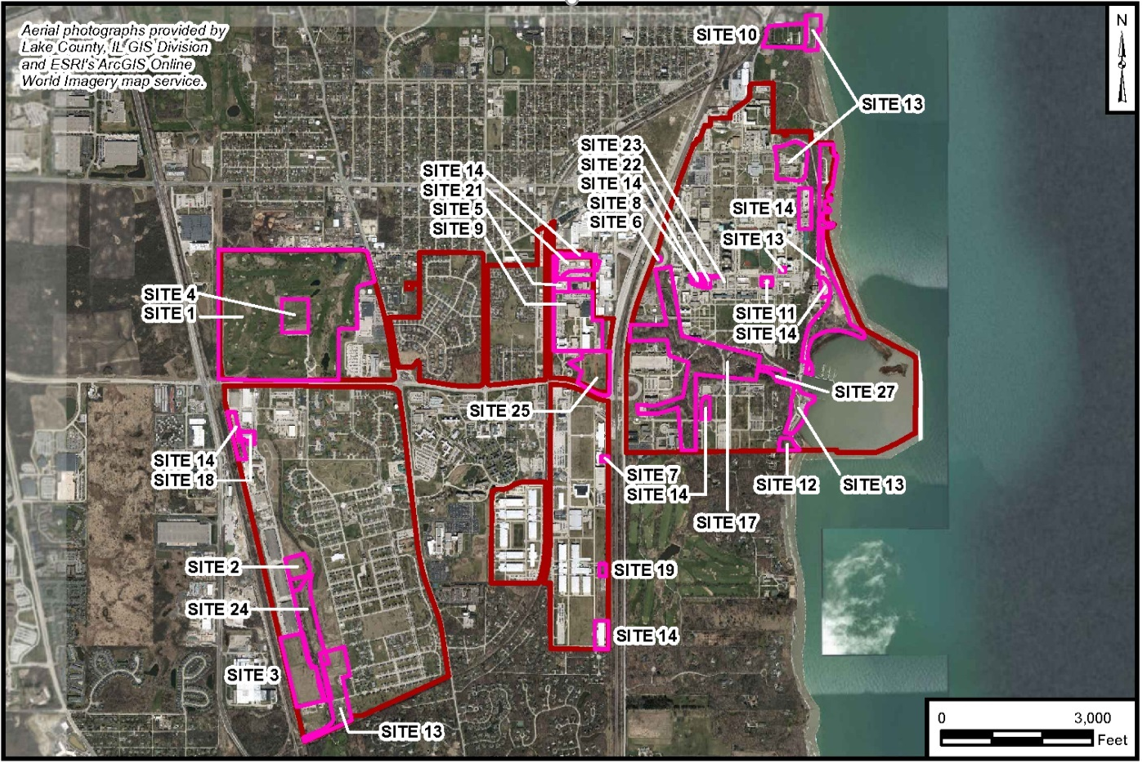Background
Naval Station Great Lakes is located in Lake County in northeastern Illinois. It is bounded by the City of North Chicago to the north, the Village of Lake Bluff to the south, Lake Michigan to the east, and Skokie Highway (U.S. Route 41) to the west. The Naval Station spans over 1,202 acres within both the North Chicago Branch River Drainage Basin and the Lake Michigan North Drainage Basin.
Naval Station Great Lakes was established in 1911 as a naval training station. This location was selected because of its proximity to Chicago and its access to rail transportation. The original activity comprised 39 buildings on 167 acres; after considerable expansion, the current activity now consists of 1,060 buildings upon its 1,202 acres. It is currently used for basic military training for the U.S. Navy and international military personnel, and it is used to support the Recruit Training Command and the Training Support Center.
The facility boundary for Naval Station Great Lakes is shown in red with Site boundaries outlined in pink on subsequent figures.

Environmental History
An Initial Assessment Study (IAS) was conducted in 1986 that identified potentially contaminated sites at Naval Station Great Lakes. Using information from the IAS, the Navy’s Environmental Restoration Program has identified 27 potential sites where hazardous materials may have been released to the environment (as summarized under Site Descriptions). Naval Station Great Lakes is not listed on the U.S. Environmental Protection Agency (EPA) National Priorities List as a facility that has hazardous waste sites that pose a threat to the public’s health and/or the environment and need to be addressed. However, the Navy is using the Environmental Restoration Program to conduct voluntary investigations to obtain regulatory closure of sites at Naval Station Great Lakes that have environmental impacts caused by historical disposal and operation practices.
As part of the IAS, a Confirmation Study Ranking System was used to evaluate the severity of potential problems at each site. The IAS identified 14 disposal or spill sites. Of those, the following seven sites were recommended for confirmation studies: Sites 1, 4, 5, 6, 7, 8, and 12. An eighth site (Site 10) was recommended for remedial measures only. Sites 11, 13, and 14 were identified for no further action (NFA) in the IAS.
Following the completion of various investigations and remedial actions, NFA determinations were obtained for Sites 6, 7, 16, 17 (Pettibone Creek), 18, and 20. . Site 10 was transferred to the Federal Bureau of Investigation (FBI). Site 8 was recommended for additional investigation. Remedial alternatives were developed for Site 25 (Camp Moffett) and a Proposed Plan (PP) presenting the preferred remedial alternative is being developed. A remedial alternative was selected for Site 27 (Boat Basin) and a plan is being developed to implement Land Use Controls (LUCs). Remedial action is in progress at Site 24 (Panhandle) and planned for Site 26 (Glenview Landfill). LUCs inspections are occurring at the remainder of the sites (Sites 1, 2, 3, 4, 5, 9, 12, 19, 21, and 22). LUC inspections also occur at several buildings with underground storage tanks (USTs) at Naval Station Great Lakes. The USTs were investigated under the Illinois EPA Petroleum Program. The following is a summary of major investigations and studies for Naval Station Great Lakes to date.
| Event |
Date |
| IAS |
1986 |
| Remedial Investigations/Risk Assessments (RIs/RAs) |
2001-2014 |
| Interim Remedial Actions, Site 7 and Site 22 |
2002 and 2012 |
| Feasibility Studies (FSs) |
2005-present |
| Record of Decision (ROD), Site 7 |
2003 |
| ROD, Site 16 |
2008 |
| ROD, Site 22 |
2008 |
| ROD, Site 1 and Site 4 |
2010 |
| ROD, Site 17-Pettibone Creek |
2013 |
| ROD, Site 19 |
2013 |
| ROD, Site 5, Site 9, and Site 21 |
2014 |
| ROD, Site 12 |
2016 |
| First Five-Year Review |
2016 |
| ROD, Site 26 |
2018 |
| Second Five-Year Review |
2020 |
| Action Memorandum Non-Time-Critical Removal Action, Site 24 |
2020 |
| ROD, Site 27 |
2021 |